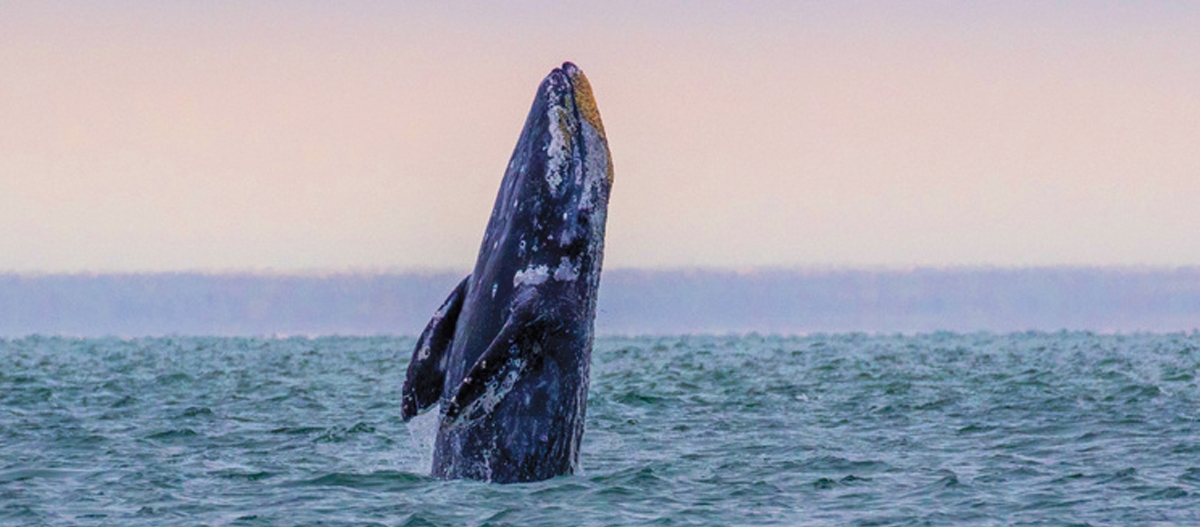Oregon is blessed with a parade of whales twice a year. In fall, gray whales migrate from northern waters, usually off the coast of Alaska in the Bering and Chuckchi Seas to their calving grounds in the coastal waters of Baja California, Mexico. In March, visitors can see the return parade heading north again to essential feeding grounds. Although there are around 200 resident whales that live off the central Oregon coast all year, the official spring whale watching time for the gray whale migration this year is March 21-29. During this week, volunteers are available at 24 “Whale Watching Spoken Here” sites sponsored by the Oregon State Park system.
During the busiest weeks, thousands of whales swim by the Oregon coast with their young, which were born in the warm waters off Mexico. Nonbreeding males and females begin the trek first, followed by mothers with newborn calves later in the spring.
Gray whales have no dorsal fins but have distinctive and visible tail flukes. They usually travel in small groups, called pods.
Scientists estimate that around 20 thousand whales migrate along this route.
Gray whales make the longest round-trip migration of any mammal, traveling from 10 thousand to 12 thousand miles. Adult gray whales are between 45 and 50 feet in length, with females larger than males and tipping the scales at 80 thousand pounds.
Their bodies are gray with obvious white patches, which are actually spots where barnacles and lice have attached to the whale.
An adult gray whale can carry up to 400 pounds of barnacles and lice on its body.
Gray whales are baleen whales with about 300 plates of baleen hanging from their upper jaw. To eat, baleen whales roll on their sides and slurp sediment off the ocean floor into their mouth. They then push water through the baleen to filter the food they’ve “Hoovered” up.
Amphipods, small creatures related to shrimp that live on the ocean floor, are the major food source. Gray whales have no dorsal fins but have distinctive and visible tail flukes.
Rather than a straight column of air, when gray whales blow, viewers will usually see a spray of fine mist as they exhale. Gray whales dive between three to six minutes at a time, then surface with a series of three to five blows in a row.
Other whale species may be seen along the Oregon coast as well. Occasionally blue whales have been sighted by folks on fishing or bird watching off-shore trips. These are the most endangered of all whales.
Minke whales are one of the smallest baleen whales. They typically top out at 35 feet. While feeding along the coast, these black or dark gray whales with a white underbelly surface with their snout first and are more active on the surface than other species.
They breach frequently and have a small, busy blow 6 to 10 feet high. Humpback whales stay between 5 and 15 miles off shore so are most often seen by anglers. They eat up to 3 thousand pounds of food a day, mostly krill and small fish.
These are the whales that breach spectacularly, often slapping their tales on the water as they explode from the ocean.
Sperm whales are another off-shore traveler along the Oregon coast. They are the largest of the toothed whales, and it’s mostly off-shore anglers and birders who see them.
Orcas are most often seen between Depoe Bay and Newport right around mid-April as they wait for newborn gray whales to eat if they can. Orcas eat mostly salmon but will also go for seals and other fish.
A special Whale Watching Center is located at charming Depoe Bay, about mid-way along the coast. The center is open all year, Wednesday to Sunday from 10 a.m. to 4 p.m. Even during off-migration times, the center is a great place to learn about whales, and, usually, visitors have a good chance of spotting whales.
Peak times often see thirty whales an hour cruising by. Several companies also offer whale-watching tours out of diminutive Depoe Bay, as well as several in Newport, some with credentialed biologists.
Before you leave Depoe Bay, be sure to check out the Whale, Sea Life, and Shark Museum, a small education center jam-packed with information.
Gray whales are a conservation success story. In the early 1900s hunting for whales had reduced the population to around 2 thousand animals. In 1946, an international agreement was crafted to end the hunting of gray whales.
With that reprieve, whales rebounded and, by 1994, where taken off the Endangered Species List. Gray whales are found only in the Pacific Ocean.
Before you visit, go on line to OregonStateParks.org for an easy-to-read map of all the whale watching spots with volunteers available to answer questions. You can also call the state park division at 541-756-3304. State Park staff can be found along the sea wall in Depoe Bay during that special week as well.
Pick a calm day for whale watching, and don’t forget to pack your binoculars! ISI










